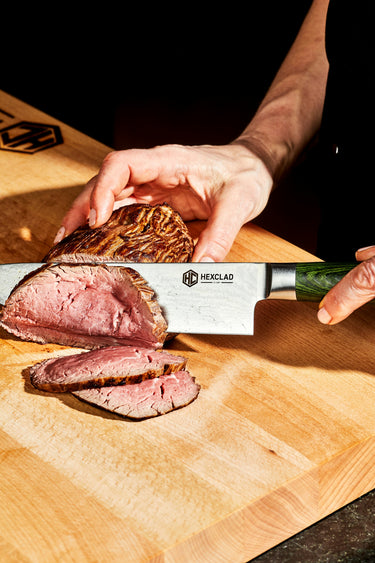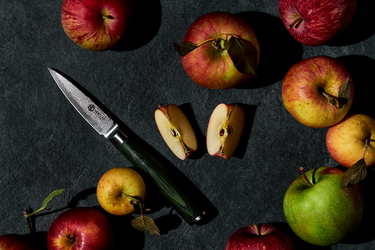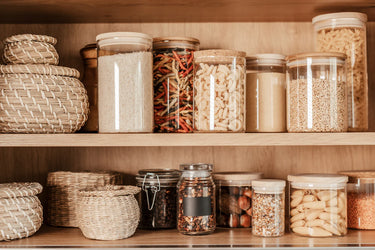Knife Tangs 101: Different Types & When To Use Each

When we think about knives, we typically think about the blade. The sharp part of the knife that does the actual cutting gets all the glory. But every knife contains an arguably equally important piece: the knife tang.
The humble tang goes largely unseen and unrecognized but is vital in ensuring prep work is safe, comfortable, and efficient.
So what exactly is the knife tang, and what type of tang is best for your needs? Read on for the full scoop.
What Is a Knife Tang?
Picture your trusty kitchen knife.
We bet you imagine the metal of the blade and the material that forms the knife’s handle. These are the visible parts of your knife you are likely intimately familiar with. But, within the handle is the blade's unsharpened back end, known as the tang.
The knife tang is the unsharpened part of the metal blade that reaches back into the handle. Without the tang connecting the blade to the handle, the knife would be too weak to handle the stress we put on it during cutting tasks and would easily break apart where the blade meets the end of the knife.
Luckily, the tang provides the stability and balance needed to tackle tough kitchen tasks. But, not all tangs are made equal.
There are two main types of knife tangs: full-tang and partial-tang.
What Does Full-Tang Mean?
A full-tang knife is one in which the metal of the blade extends all the way to the handle’s end.
Full tangs are similar in shape and size to the handle, with metallic rivets and epoxy fastening them together.
While a full-tang knife must have a blade that extends through the handle, the width of the handle may be larger than that of the tang.
Full-tang knives are typically stronger and offer better balance and control when handling. By creating a balance point that falls toward the center of the knife for added leverage and ease of use.
What Does Partial-Tang Mean?
While partial tangs still extend into the handle, these knives do not extend the full way back as full tangs do. Instead, the metal of partial tangs only goes partway into a knife's handle.
With less metal, partial-tang knives are often cheaper but offer less balance and support. They are not as durable or as easy to control as full-tang knives.
What Are the Different Types of Full-Tang Knives?
All full-tang knives have tangs that reach the back of the handle, but the shapes and the knife-making process can vary from type to type.
The main types of full-tang knives include the hidden tang, encapsulated tang, extended tang, and skeletonized tang. Yes, it’s wordy. But if you want to know you’re getting a good knife, you need to know this stuff.
Hidden Tang
The hidden tang is a type of full-tang knife in which the tang is — you guessed it — completely hidden. The knife's handle fully covers this invisible piece of the blade. While you wouldn’t know the hidden tang was there just by looking at the knife, you can feel the difference in the knife's balance and durability.
Another defining quality of the hidden tang is that the tang's width is thinner than that of the blade. This means that compared to other full-tang options, a larger area of the knife’s handle is made of a different material than the metal tang.
Knifemakers usually rely on hidden tangs to create unique and aesthetically pleasing handle designs that still possess the durability of a full-tang knife.
Hidden tangs are also lighter than other full-tang designs, which your arm might appreciate when you’re doing a lot of prep work. However, the downside is that thin, hidden tangs provide less strength than thicker, full tangs.
Encapsulated Tang
Like the hidden tang knife, an encapsulated tang is completely encapsulated within the handle. The key difference is the tang's width: encapsulated tangs are wider, as the tang more closely matches the blade in size.
When it comes to encapsulated tangs, the bulk of the handle is made of the metal tang. The handle material that wraps around the tang is known as the handle scales or slabs.
Encapsulated tangs provide desirable stability and control via balanced weight distribution, which is vital to cutting through thick or hardy ingredients.
Extended Tang
Extended tangs go above and beyond, with a portion of the tang extending slightly past the end of the knife’s handle. This visible piece of the tang forms a curved pommel that serves as the butt of the knife. It’s more durable than other knife butt materials.
The extended portion of the tang also works as a hammer pommel, coming in handy when cracking nuts, for instance.
While there may not be as many options for handling material for extended tang knives, these knives are extremely strong and resilient.
Skeletonized Tang
Skeletonized tangs create unique-looking knives, as the inner part of the tang’s metal is cut out, leaving an outline — or the skeleton — in its place. The skeleton takes shape towards the back of the handle so as not to weaken the portion of the handle that connects to the blade.
Once the tang is cut, the handle scales are then molded around what remains of the tang, creating open nooks and crannies within the center of the knife handle for your fingers to go.
This tang design is popular for outdoor knives and the preferred tang when it comes to throwing knives, as your fingers can wrap around the skeleton in a wide range of ways. And — while we don’t recommend attempting knife-throwing at home — these knives can certainly have their place in your kitchen.
Skeletonized knives are a lighter full-tang option that is considered stronger than hidden tangs since the outer width of the metal is kept intact. While these knives aren’t as strong as encapsulated or extended tang knives, well-made skeletonized knives can still offer durability and a comfortable grip.
What Are the Different Types of Partial-Tang Knives?
We’ve covered the classic full-tang constructions, but what about partial-tang knives?
Rat-tail tang, tapered tang, and push tang are all considered partial-tang designs, with the unsharpened part of the blade only extending partially into the handle of the knife.
Rat-Tail Tang
If you’re imagining a thin rat’s tail, you’ve got a pretty good idea of what the inner metal within the handle of a rat-tail knife looks like.
While rat-tail tangs or stick tangs extend back to the base of the handle, they do so in the form of an ultra-thin, rat-tail-sized strip of metal. But what is saved in metal (and money) is lost in stability.
The rat-tail tang provides less balance and strength than any full-tang designs we’ve discussed and is considered the weakest tang overall. Due to the rat-tail’s uneven weight distribution, these knives are harder to control and, therefore, less safe and effective, especially when cutting through thicker foods.
Tapered Tang
The tapered tang resembles a full-tang knife but isn’t quite as strong. While wide near the front of the handle, the tapered tang gradually tapers off to a thin point as it nears the butt of the handle.
Because the tapered tang becomes narrower as it extends further back, the tapered tang uses less metal and is, therefore, more lightweight and affordable to produce than full-tang knives.
However, the tapered tang contains enough metal throughout the handle to ensure the knife has structural integrity and durability — albeit not as much as true full-tang knives.
Push Tang
A push tang is quite literally pushed inside a pre-existing knife handle. Fixed into place with epoxy, push tangs usually extend around halfway or three-quarters of the way into the handle.
Like other partial-tang designs, the push tang is often lighter and less expensive to produce but is also less strong than knives containing a more robust tang.
When Should You Use Full-Tang Knives?
Here at HexClad, we are true advocates of the full-tang knife. With the sturdy metal that creates the blade extending through the full length of the handle, full-tang knives are a must-have when working with thick skins or tough cuts of meat.
When we cook, we put pressure on the blade, which can cause stress. If the tang end falls within the handle, it leads to a weak point that can break under stress. Full tangs that extend to the butt of the knife, however, distribute the pressure more evenly for a more durable and easy-to-control knife.
With this in mind, your best bet is to opt for full-tang construction when it comes to the knives you use for your everyday tasks and heavy-duty cutting, such as your chef's knife, cleaver, and santoku knife.
Whether you are halving butternut squash, chopping potatoes, slicing pork shoulder or shank, or cutting through bone, a full-tang knife is the most reliable option.
The weight distribution, balance, and added strength provided by the full-tang will ensure your prep work endeavors are successful and safe.
When Should You Use Partial-Tang Knives?
Partial-tang knives are typically lighter than full-tangs since they contain less metal. However, this also means partial tangs have more weak spots and are more likely to crack under stress.
Partial-tang knives are often used for decorative knives since these knives don’t need to withstand much pressure. Outdoor folding knives and pocket knives may also benefit from a partial tang, as their lightness makes them easier to carry.
However, when it comes to your kitchen knives, full-tang knives can provide better stability and leverage for any and every cutting task.
The Bottom Line
The tang of a knife does a lot of heavy lifting behind the scenes, so you want to ensure your tang is well-suited to take on any task you throw its way.
Full tangs extend the length of the handle to provide optimal resilience and balance.
Here at HexClad, all of our knives are forged from 67 layers of high-quality Damascus steel and feature a full-tang construction that can help you slice and dice your way through prep work with ease.
Our essential six-piece knife set with block provides sleek, durable, and attractive knives that complement your kitchen and serve as the ultimate cooking companions. Happy cooking!
Sources:
A Deep Dive into How Knife Blades are Made | Popular Science
Parts of a Knife - Anatomy of a Chef’s Best Friend | Healthy Kitchen 101





